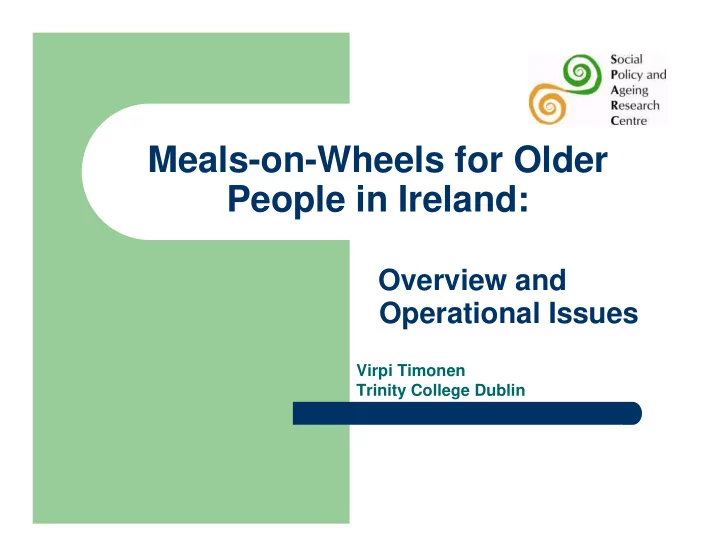

Meals-on-Wheels for Older People in Ireland: Overview and Operational Issues Virpi Timonen Trinity College Dublin
Overview of presentation � Short introduction to the study � How we conducted the study � Central characteristics of MOW clients � Key findings on operational issues � Conclusions
Short introduction to the study Very limited knowledge of meals-on-wheels 1. Importance of food for both health and quality 2. of life MOW as central component of home and 3. community care Set out to map out and explore operational, 4. social and nutritional aspects of MOW
Summary of Data Collection and Methods Phase One Postal Survey of all known Meals on Wheels Services (RR = 69%, N = 280) Phase Two Interviews with Providers: Co-ordinators (n=15) Paid staff (n=6) Volunteers (n=9) Analysis of nutrient content of sample meals from 8 organisations Phase Three Interviews and Nutritional Assessments with 63 Meals-on-Wheels Recipients
Central characteristics of MOW clients � 2.4 % of older people use MOW (10,000 – 12,000 individuals) � 60 % aged 75 + � 2/3 female � 70 % live alone
Key findings on operational aspects � Legal status � Staffing � Perceived central aim � Service days per week � Choice, communication channels � Training, advice � Eligibility criteria � Funding � Perceived challenges
Legal status, % Registered charity 43 HSE 16 Limited company 7 No formal status 18 Mixed status 16
Staffing 4% 7% Paid Full-time Paid Part-time Volunteers 89%
Key characteristics � Highly localised � Characterised by volunteerism � Organic, rather than planned growth to date � Uneven coverage across country
Perceived central aim, % Provide meals for those unable to cook 60 for themselves Provide meals AND social contact 17 Caring for older people and people with 11 disabilities Enabling people to live in their own 8 homes Combat social isolation 2 Develop the organisation 2
Service days per week 1 - 2 days 19 % 3 – 4 days 37 % 5 days 29 % 6 – 7 days 14 %
Choice, communication � 97 % provide hot meals � 39 % provide choice of meals � 71 % use menu rotation � 68 % cater for special dietary requirements � 74 % have a feedback / complaints mechanism
Training, advice � 68 % had sent at least one staff member trained in food safety � 25 % had at least one staff member trained in nutritional requirements of older people � 26 % had received input into menu planning from a dietitian
Use of eligibility criteria 28% Yes 39% Sometimes/It depends No 33%
Funding Significant multiplier effect: Average HSE subsidy € 1.28 (Incl. capital funding) € 2.94 Average client charge € 2.69 (Variance in client charge € 0.76 – 6.50) Other funding TOTAL average cost €6.33
% of organisations stating their greatest challenge is… Recruiting new volunteers 48 Sourcing funding 23 Meeting increased demand 10
Conclusions � Central to ensuring older people can continue living at home � Need for a clear policy framework � More support for providers � Clarify basis of entitlement � Introduce nutritional guidelines � Focus on both social and nutritional aspects of service
Recommend
More recommend